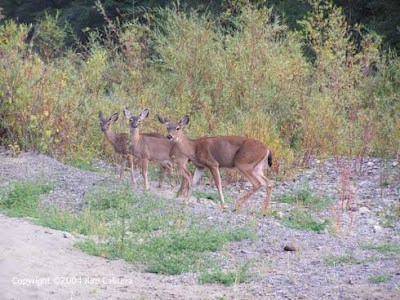

|
|
Hungry deer are a constant issue for foothill
gardeners. (Photo courtesy UC IPM)
|
It’s a constant question from foothill gardeners: What will deer NOT eat?
Find out during a free virtual workshop, “Living with Deer as a Foothill Gardener.”
Hosted by the UC Cooperative Extension Master Gardeners of Nevada County, this Zoom session is open to the public regardless of where they live. Set for 9 a.m. Saturday, Oct. 16, the workshop has no pre-registration; just click on the link and join in.
Deer rank among the most frustrating issues for foothill gardeners – and some Valley gardeners, too. These large mammals seem to always be hungry, and our gardens look so appetizing.
“Although there are no guarantees when gardening in deer country, there are ways to live with these browsers and have a lovely landscape and garden veggies as well,” say the master gardeners. “To learn more about managing deer in foothill gardens, join us to learn facts about the deer in our area and ways you can defend your gardens and landscape.”
Deer not only have big appetites; they can be just plain big. Mule deer, the most common species in the Sierra foothills and California’s only native deer species, can reach 6 feet tall and weigh 200 pounds. And they can jump!
Right now, deer are fattening up for the winter on acorns and other nutrient-rich foods. But they don’t care for lavender, rosemary or other pungent herbs. Think like a deer and, yes, you can redirect them away from your garden to native oaks and other more appropriate food sources.
More details and Zoom links (including passcode): https://ncmg.ucanr.org/ .
Comments
0 comments have been posted.Sacramento Digs Gardening to your inbox.
Sites We Like
Garden Checklist for week of July 21
Your garden needs you!
* Keep your vegetable garden watered, mulched and weeded. Water before 8 a.m. to reduce the chance of fungal infection and to conserve moisture.
* Feed vegetable plants bone meal, rock phosphate or other fertilizers high in phosphate to stimulate more blooms and fruiting. (But wait until daily high temperatures drop out of the 100s.)
* Don’t let tomatoes wilt or dry out completely. Give tomatoes a deep watering two to three times a week.
* Harvest vegetables promptly to encourage plants to produce more. Squash especially tends to grow rapidly in hot weather. Keep an eye on zucchini.
* Pinch back chrysanthemums for bushy plants and more flowers in September.
* Remove spent flowers from roses, daylilies and other bloomers as they finish flowering.
* Pinch off blooms from basil so the plant will grow more leaves.
* Cut back lavender after flowering to promote a second bloom.
* It's not too late to add a splash of color. Plant petunias, snapdragons, zinnias and marigolds.
* From seed, plant corn, pumpkins, radishes, winter squash and sunflowers.